Putting together a computer rack
This post is about how to place more than a dozen electronic devices in a conventional rack.
At the same time, everything looks neat, does not overheat, and two multifunctional folding tables are a bonus.

Now, in order about the filling rack.
0. L-shaped folding doors / tables. Made of 10mm plywood, glued on both sides with 3mm white plexiglass. The end face is machined with an aluminum edge profile.
Plexiglas was purchased on the construction market (sheet 6 sq. M.).
At first, 6 squares seemed to be a large margin, but while he was cutting out L-shaped pieces, several blanks cracked and there was no stock left.
Doors in the open state rest on the armrests of the sofa. However, having assembled the entire structure, I realized that they are too flexible and nothing can be put on them. The tables caved in even under their own weight.
Therefore, a mechanism was developed that supports the edge of the door, here it is:

It consists of a steel chain, which is fixed to the rack and the edge of the door, and in the open state does not allow the door to bend.
The door can withstand 5 - 10 kg in this way, which is quite enough for plates, mugs, a monitor, etc.
To ensure that when closing / raising the door, the chain does not dangle outside, it is fixed on a fishing line that is wound around the mechanism from the tape measure. The photo shows how the chain folds neatly when lifting the door.
In a vertical state, the door is held by a furniture magnet.
1. An old, but faithful, Dual Xeon with a TV tuner, which now mainly serves as a media center and torrent client, but sometimes you can work and play on it.

It is arranged as follows:
1.0.The computer is located in the central cell of the rack, which is internally laid with a centimeter layer of “foam” for sound insulation.
1.1. The motherboard is installed in a piece of the old case, from which all the excess is cut off by the grinder.
1.2., 1.3. Square tubes made of cardboard packaging are put on one end on the processor cooler, which, I recall, are two, and the other end of the tubes is inserted into the slot in the wall of the rack.
They remove all the heat from the processors to the next cell in the rack, preventing the entire computer from overheating.
1.4. The hard rack, pulled out of the old case, is located behind the cardboard tubes.
1.5. Power Supply. Embedded on one side of the wall of the rack, and the other rests on a rack with hards.
From the side of the neighboring cell, it looks like this: The

cooler of the power supply, like the processor cooler, draws air from the cell with the computer, from the hot hard, preventing the temperature inside the computer from rising.
Because when the temperature inside the cell with the computer rises, the cooler procs begin to work at increased speeds and create excess noise that interferes with watching the movie.
The cell next to the computer, where all the hot air is taken out, thus warms up significantly, now it has 38 degrees, when in room 23. And this is when the computer is idling on the distribution of torrents.
When the hot water was turned off, I put several five-liter bottles of water in the cell in the evening and washed it perfectly in the morning, it was much more convenient than messing with teapots and pans.
True, I started to get a little annoyed by the cost of electricity, so I'm thinking about something more economical.
1.6. Ordinary dvd cutter, fit the boot in the boot.
1.7. A hole is seen from above in the cell, through which the "cold" air is sucked in / enters the computer. By the way, there is another cooler under it, which directs the air flow to the tuner, sound and video card so that they do not overheat.
1.8. Button on / off lonely settled on the edge of the hull.
1.9.The photo shows the edge of the door with hinges and two wires - green and red, which are “stuck” into the door. In fact, these are power and hdd LEDs that are glued in the holes that reach the middle of the outer layer of plexiglass and are visible from the outside of the rack with the door closed. This is not very necessary, but if you go into the room at night, then the shelf winks affably.
2. The monitor. I use it, if I need to work, then I take it out of the cell and put it on the folding table.
3. Speakers from the audio system. In fact, this is only the rear. In front are three more columns. The sub is located at the bottom right.
4. DECT Telephone and IP (SIP) telephone in one device.
5. TV decoder (IPTV set-top box), connected to a TV tuner in a computer.
6.Scanner.
7. If you need to wake up, the rack brews coffee.
8. Projector. Projects an image from the computer onto the wall, opposite the rack, which is painted white. By the way, the black color of the back wall was not chosen randomly, but in order to reduce the amount of spurious light entering the “screen”. Basically, the projector is used to watch movies and TV, sometimes for work, as an additional monitor.
He really turned upside down, this is normal, it saved money on a special mount.
9.New Router. He breathes fresh air from the outside, next to him is a hole through which hot air comes out of the rack. The old router lived inside the cell, above the scanner, at a temperature of 38-40 degrees and, apparently, therefore, his life was not long.
10. An external hard next to the router, because, at first, it was stuck in it, but it was sooooo slow. Now the hard plug into the computer directly. When the rack was being designed, I did not expect a quick increase in outlet consumers in this cell and there was not enough power for it, it’s good that he reached for a spare one to the right of the monitor.
eleven.Despite all my efforts on the ventilation system, all this stuffing (and there’s also the wife’s technique), gives off so much heat that it can fry us to a crisp in one episode of Doctor House. I had to install the air conditioner, the remote control from it is higher, otherwise it will be eaten by an excessively curious son.
12.IR extension cable. He controls the IPTV set-top box, the signal from which goes to the computer, and from the computer not only to the monitor and projector, but also to the monitor in the kitchen, where you can also watch movies, TV or check mail. In order to switch channels from the kitchen to the IPTV set-top box, an IR signal extension is used. Damn, well, they would do the control of the console from the computer, I would switch the wireless mouse from anywhere, and this IR extender works every other time, it's terribly inconvenient. Well, at least so, otherwise I would have to run from room to room to switch channels.
Along with the video, an audio cable from the sound is also laid in the kitchen, since I have 7.1. 5.1 are used in the hall and 2.1 in the kitchen.
13.Before the heap, the IPTV set-top box is stuck in a separate switch (the cost of which is included in the rental of the set-top box). Of course, you could stick it in the router, but there you have to bother with the VLAN settings, and the ports are all busy there.
I am writing about it all so that you can imagine the volume of wires that the rack hides in itself. By the way, a separate power wiring from the distribution panel was connected to it (with a separate RCD / machine, respect to my neighbor for installing it). This whole pile is neatly laid in the baseboard with a triple cable channel, nothing hangs anywhere in the air, does not lie on the floor. The liner from the baseboard to the rack also passes through the boxes. The amount of work that we did then was fully appreciated with the appearance of a child who lives quietly in the apartment, and we are not afraid that he will eat this or that wire.
Now about how it all was going.
First there were legs ...
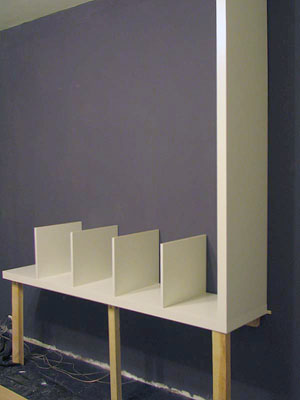
The base of the rack rests on three legs and on a rail, which is bolted to the wall. An empty rack weighs 95 kg and it was decided to collect it already on the wall, because we could not raise 95 kg and put it on our feet. It turned out that assembling a rack on the wall is also very inconvenient.
After several hours of maturation, the frame of the rack was assembled and stood on its feet. There was a ball of wires lying under our feet:
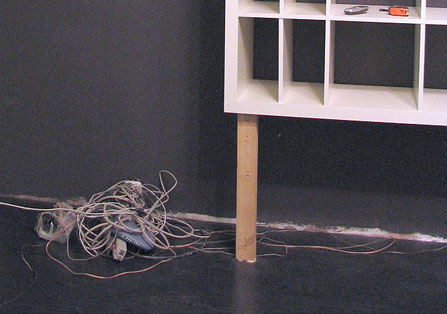
We are starting to unravel the ball and trying to assemble a computer and basic Internet access systems.
Finally IT worked and you can check the mail:

It can be seen in the photo that the location of the computer is different from what happened at the end, because at first it was necessary to assemble it wrong, to understand that it was overheating, to mumble and assemble it using a new, directly agile one.
Finally, the "configuration" of the computer has settled down and begin to wiring to the rack:
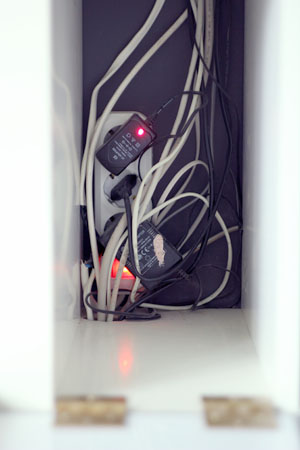
This is the "information input" on the left side at the base of the rack. On the other hand there are fewer wires - there is only audio wiring to the subwoofer and from it to the speakers.
Finally, the wiring and basic devices in place, everything is almost ready:
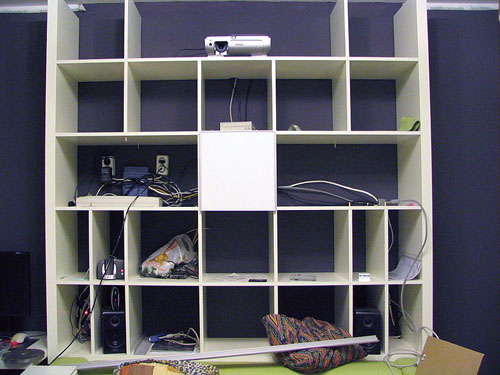
Pay attention to how part of the walls of the rack was moved to form L-shaped forms.
By the way, the photo shows the “Old Router” of blue color, stuck between two outlets, just in the way of hot air from the computer, he had only a few days to live.
It remains only to assemble the L-shaped doors and make the door under the rack:
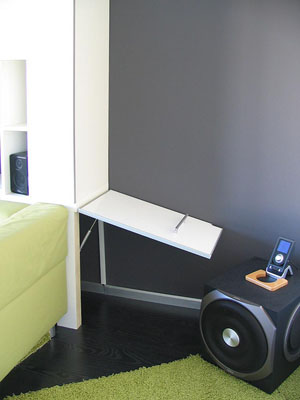
Of course, the place under the rack is also used, it's a pity the sub did not fit in there, I had to fill the place with other trash. In the photo you can see the "gas-lift", which keeps the door open, preventing it from hammering you on the back while you are trying to get it or put something under the shelf with a cancer.
Behind the baseboard and the white vertical box is wiring to the subwoofer and from it to the speakers.
Now everything is finished and looks like this:
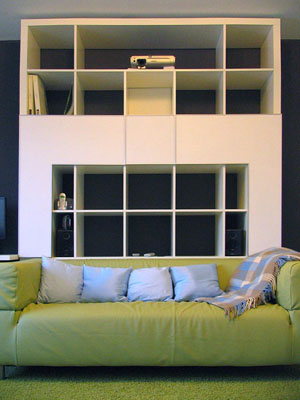
And here is the horror that was before the appearance of the rack:
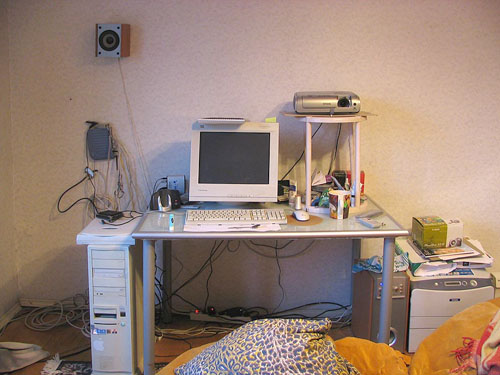

At the same time, everything looks neat, does not overheat, and two multifunctional folding tables are a bonus.

Now, in order about the filling rack.
0. L-shaped folding doors / tables. Made of 10mm plywood, glued on both sides with 3mm white plexiglass. The end face is machined with an aluminum edge profile.
Plexiglas was purchased on the construction market (sheet 6 sq. M.).
At first, 6 squares seemed to be a large margin, but while he was cutting out L-shaped pieces, several blanks cracked and there was no stock left.
Doors in the open state rest on the armrests of the sofa. However, having assembled the entire structure, I realized that they are too flexible and nothing can be put on them. The tables caved in even under their own weight.
Therefore, a mechanism was developed that supports the edge of the door, here it is:

It consists of a steel chain, which is fixed to the rack and the edge of the door, and in the open state does not allow the door to bend.
The door can withstand 5 - 10 kg in this way, which is quite enough for plates, mugs, a monitor, etc.
To ensure that when closing / raising the door, the chain does not dangle outside, it is fixed on a fishing line that is wound around the mechanism from the tape measure. The photo shows how the chain folds neatly when lifting the door.
In a vertical state, the door is held by a furniture magnet.
1. An old, but faithful, Dual Xeon with a TV tuner, which now mainly serves as a media center and torrent client, but sometimes you can work and play on it.

It is arranged as follows:
1.0.The computer is located in the central cell of the rack, which is internally laid with a centimeter layer of “foam” for sound insulation.
1.1. The motherboard is installed in a piece of the old case, from which all the excess is cut off by the grinder.
1.2., 1.3. Square tubes made of cardboard packaging are put on one end on the processor cooler, which, I recall, are two, and the other end of the tubes is inserted into the slot in the wall of the rack.
They remove all the heat from the processors to the next cell in the rack, preventing the entire computer from overheating.
1.4. The hard rack, pulled out of the old case, is located behind the cardboard tubes.
1.5. Power Supply. Embedded on one side of the wall of the rack, and the other rests on a rack with hards.
From the side of the neighboring cell, it looks like this: The

cooler of the power supply, like the processor cooler, draws air from the cell with the computer, from the hot hard, preventing the temperature inside the computer from rising.
Because when the temperature inside the cell with the computer rises, the cooler procs begin to work at increased speeds and create excess noise that interferes with watching the movie.
The cell next to the computer, where all the hot air is taken out, thus warms up significantly, now it has 38 degrees, when in room 23. And this is when the computer is idling on the distribution of torrents.
When the hot water was turned off, I put several five-liter bottles of water in the cell in the evening and washed it perfectly in the morning, it was much more convenient than messing with teapots and pans.
True, I started to get a little annoyed by the cost of electricity, so I'm thinking about something more economical.
1.6. Ordinary dvd cutter, fit the boot in the boot.
1.7. A hole is seen from above in the cell, through which the "cold" air is sucked in / enters the computer. By the way, there is another cooler under it, which directs the air flow to the tuner, sound and video card so that they do not overheat.
1.8. Button on / off lonely settled on the edge of the hull.
1.9.The photo shows the edge of the door with hinges and two wires - green and red, which are “stuck” into the door. In fact, these are power and hdd LEDs that are glued in the holes that reach the middle of the outer layer of plexiglass and are visible from the outside of the rack with the door closed. This is not very necessary, but if you go into the room at night, then the shelf winks affably.
2. The monitor. I use it, if I need to work, then I take it out of the cell and put it on the folding table.
3. Speakers from the audio system. In fact, this is only the rear. In front are three more columns. The sub is located at the bottom right.
4. DECT Telephone and IP (SIP) telephone in one device.
5. TV decoder (IPTV set-top box), connected to a TV tuner in a computer.
6.Scanner.
7. If you need to wake up, the rack brews coffee.
8. Projector. Projects an image from the computer onto the wall, opposite the rack, which is painted white. By the way, the black color of the back wall was not chosen randomly, but in order to reduce the amount of spurious light entering the “screen”. Basically, the projector is used to watch movies and TV, sometimes for work, as an additional monitor.
He really turned upside down, this is normal, it saved money on a special mount.
9.New Router. He breathes fresh air from the outside, next to him is a hole through which hot air comes out of the rack. The old router lived inside the cell, above the scanner, at a temperature of 38-40 degrees and, apparently, therefore, his life was not long.
10. An external hard next to the router, because, at first, it was stuck in it, but it was sooooo slow. Now the hard plug into the computer directly. When the rack was being designed, I did not expect a quick increase in outlet consumers in this cell and there was not enough power for it, it’s good that he reached for a spare one to the right of the monitor.
eleven.Despite all my efforts on the ventilation system, all this stuffing (and there’s also the wife’s technique), gives off so much heat that it can fry us to a crisp in one episode of Doctor House. I had to install the air conditioner, the remote control from it is higher, otherwise it will be eaten by an excessively curious son.
12.IR extension cable. He controls the IPTV set-top box, the signal from which goes to the computer, and from the computer not only to the monitor and projector, but also to the monitor in the kitchen, where you can also watch movies, TV or check mail. In order to switch channels from the kitchen to the IPTV set-top box, an IR signal extension is used. Damn, well, they would do the control of the console from the computer, I would switch the wireless mouse from anywhere, and this IR extender works every other time, it's terribly inconvenient. Well, at least so, otherwise I would have to run from room to room to switch channels.
Along with the video, an audio cable from the sound is also laid in the kitchen, since I have 7.1. 5.1 are used in the hall and 2.1 in the kitchen.
13.Before the heap, the IPTV set-top box is stuck in a separate switch (the cost of which is included in the rental of the set-top box). Of course, you could stick it in the router, but there you have to bother with the VLAN settings, and the ports are all busy there.
I am writing about it all so that you can imagine the volume of wires that the rack hides in itself. By the way, a separate power wiring from the distribution panel was connected to it (with a separate RCD / machine, respect to my neighbor for installing it). This whole pile is neatly laid in the baseboard with a triple cable channel, nothing hangs anywhere in the air, does not lie on the floor. The liner from the baseboard to the rack also passes through the boxes. The amount of work that we did then was fully appreciated with the appearance of a child who lives quietly in the apartment, and we are not afraid that he will eat this or that wire.
Now about how it all was going.
First there were legs ...

The base of the rack rests on three legs and on a rail, which is bolted to the wall. An empty rack weighs 95 kg and it was decided to collect it already on the wall, because we could not raise 95 kg and put it on our feet. It turned out that assembling a rack on the wall is also very inconvenient.
After several hours of maturation, the frame of the rack was assembled and stood on its feet. There was a ball of wires lying under our feet:

We are starting to unravel the ball and trying to assemble a computer and basic Internet access systems.
Finally IT worked and you can check the mail:

It can be seen in the photo that the location of the computer is different from what happened at the end, because at first it was necessary to assemble it wrong, to understand that it was overheating, to mumble and assemble it using a new, directly agile one.
Finally, the "configuration" of the computer has settled down and begin to wiring to the rack:

This is the "information input" on the left side at the base of the rack. On the other hand there are fewer wires - there is only audio wiring to the subwoofer and from it to the speakers.
Finally, the wiring and basic devices in place, everything is almost ready:

Pay attention to how part of the walls of the rack was moved to form L-shaped forms.
By the way, the photo shows the “Old Router” of blue color, stuck between two outlets, just in the way of hot air from the computer, he had only a few days to live.
It remains only to assemble the L-shaped doors and make the door under the rack:

Of course, the place under the rack is also used, it's a pity the sub did not fit in there, I had to fill the place with other trash. In the photo you can see the "gas-lift", which keeps the door open, preventing it from hammering you on the back while you are trying to get it or put something under the shelf with a cancer.
Behind the baseboard and the white vertical box is wiring to the subwoofer and from it to the speakers.
Now everything is finished and looks like this:

And here is the horror that was before the appearance of the rack:


